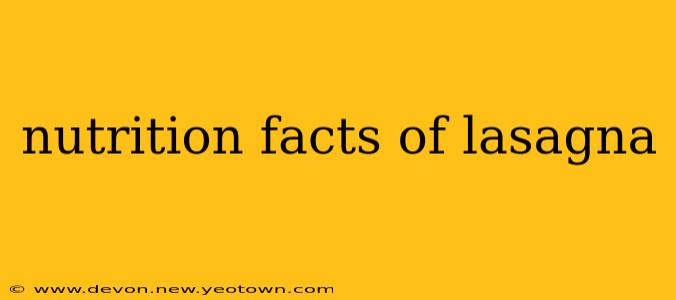Lasagna. The name conjures images of bubbling cheese, rich tomato sauce, and perfectly layered pasta. But beneath the delicious exterior lies a nutritional story, one that can vary wildly depending on the recipe. Let's embark on a culinary journey to uncover the nutritional facts of this beloved dish, addressing some common questions along the way.
What are the calories in a serving of lasagna?
This is the million-dollar question, and unfortunately, there's no single answer. A serving size itself is subjective – is it a generous slice from a family-sized pan, or a more modest portion? The ingredients also dramatically impact the calorie count. A lasagna packed with meat, cheese, and creamy béchamel sauce will naturally be higher in calories than a vegetarian version with leaner ingredients and less cheese.
A typical serving of a meat lasagna might range from 300 to 500 calories, but this can easily climb to 600 or more with richer recipes. A vegetarian lasagna often clocks in at slightly lower calories, but again, ingredient choices are key. To get a precise calorie count for your lasagna, you'll need to consider the specific recipe and use a nutrition calculator, inputting the quantities of each ingredient.
How much fat, protein, and carbohydrates are in lasagna?
The macronutrient breakdown of lasagna varies greatly based on the recipe. However, we can paint a general picture. A meat lasagna typically gets a significant portion of its calories from fat, thanks to the cheese, meat, and oil used in the sauce. The protein content will be moderate to high, mainly from the meat and cheese. Carbohydrates come primarily from the pasta itself.
A vegetarian lasagna will generally have a lower fat content, although still potentially high depending on the cheese used. Protein content will be lower unless it incorporates things like lentils or beans. The carbohydrate content will largely depend on the pasta type and quantity.
Is lasagna healthy? Can it be part of a healthy diet?
The healthiness of lasagna is a matter of perspective and portion control. It's not inherently unhealthy, but it's certainly not a health food in the traditional sense. The high calorie, fat, and sodium content in many recipes makes it a dish best enjoyed in moderation.
However, it can be part of a healthy diet. By making smart ingredient swaps, you can significantly improve the nutritional profile. Opting for whole-wheat pasta, lean ground meat or vegetarian alternatives (like lentils or vegetables), reducing the cheese quantity, and using plenty of vegetables in the sauce can significantly boost the nutritional value while reducing the calorie and fat content.
What are the main ingredients that contribute to the nutritional content of lasagna?
The main players influencing lasagna's nutrition are:
- Pasta: The foundation, contributing primarily to the carbohydrate and fiber content (depending on the type of pasta).
- Meat (if included): Provides protein and fat. Leaner meats are preferable for a healthier lasagna.
- Cheese: A significant source of fat, protein, and calcium. Using less cheese or choosing lower-fat varieties makes a difference.
- Sauce: Tomatoes provide vitamins and antioxidants, but added oils and sugars can increase the fat and calorie count.
- Vegetables: Adding vegetables significantly improves the nutritional value by boosting vitamins, minerals, and fiber.
How can I make a healthier version of lasagna?
Creating a healthier lasagna is about mindful choices. Experiment with these ideas:
- Whole-wheat pasta: Adds fiber and nutrients.
- Lean ground turkey or chicken: Lower in fat than ground beef.
- Vegetarian options: Lentils, mushrooms, or spinach create hearty, lower-fat alternatives.
- Reduced-fat cheese: Still provides flavor, but with fewer calories and fat.
- Plenty of vegetables: Adds vitamins, minerals, and fiber while bulking up the meal.
- Homemade sauce: Allows you to control the sodium and added sugar content.
By making these swaps, you can enjoy a delicious lasagna without the hefty nutritional guilt. Remember, moderation is key—even a healthy lasagna should be enjoyed as part of a balanced diet.

